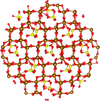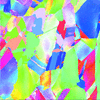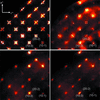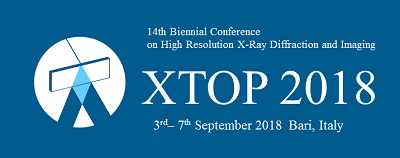issue contents
December 2017 issue

Cover illustration: Images from The electrostatic potential of dynamic charge densities [Hübschle & van Smaalen (2017). J. Appl. Cryst. 50, 1627-1636].
research papers
The computing speed of reverse Monte Carlo structure refinements has been improved by up to two orders of magnitude, which significantly expands the capabilities of this method.
A method for generating high-quality discretizations of SO(3) is described and compared with existing methods.
The first direct valence-selective structure determination by X-ray fluorescence holography is presented. This method uses the fluorescence intensity variation of specific elements close to the K absorption edge. Thereby, the different crystal structures in a mixed Y2+/Y3+ thin film of yttrium oxide are distinguished.
The size dependences of the melting and crystallization temperatures of spherical Bi nanoparticles embedded in glass were determined using combined small- and wide-angle X-ray scattering measurements for nanoparticle radii ranging from 1 to 11 nm. The results provide additional and stronger evidence supporting previous conclusions showing that, below the melting temperature, Bi nanocrystals with radii larger than 1.8 nm consist of a crystalline core surrounded by a disordered shell.
Pulsed neutron Bragg-dip transmission is an efficient method for determining the crystallographic direction of crystals lying parallel to the incident beam. The method can be used for crystalline grain identification with a spatial resolution higher than that achievable by neutron diffraction imaging.
Open  access
access
 access
accessReverse Monte Carlo software to analyze the atomic arrangements of perovskite oxide ultrathin films from the crystal truncation rod intensity is developed on the basis of Bayesian inference.
A single-particle structural model of schwertmannite is proposed from a combined multi-technique approach, using a novel reverse Monte Carlo/Debye scattering equation parallel code.
Open  access
access
 access
accessThe electrostatic potential (ESP) is computed for dynamic charge densities corresponding to multipole models and maximum-entropy densities. Convergence of the reciprocal-space summation is guaranteed by the Gaussian form of the Debye–Waller factor. Applications to serine demonstrate only a weak temperature dependence of the ESP on molecular surfaces relevant to intermolecular interactions.
Phase-retrieval algorithms combined with global optimization techniques have been shown to be robust and reliable, and to outperform phase-retrieval algorithms used in coherent diffractive imaging.
Open  access
access
 access
accessVariant selection is reported in martensite formed on the surface of an Fe–30% Ni sample. Predictive models of the phenomenon based on different crystallographic descriptions of the transformation are proposed and compared.
Generalized skew-symmetric interfacial probability density functions are used to model arbitrary interfacial density profiles for the analysis of reflectivity and small-angle scattering.
Two algorithms reliant on physics-based forward models are proposed to refine crystal orientations: a multi-resolution brute-force local search and a derivative-free optimization. The efficacy of these methods is evaluated for the electron backscatter diffraction and electron channeling pattern modalities using simulated patterns with known orientations.
A modeling framework to relate the molecular orientation of nanostructures to polarized resonant soft X-ray scattering measurements using the Born approximation and a full tensor treatment is described.
This study presents rhombohedral twin characterization in plastically deformed alumina at high-pressure and -temperature conditions using electron channeling contrast imaging (ECCI) in a field emission scanning electron microscope, electron backscatter diffraction (EBSD) and elastic plastic self-consistent (EPSC) numerical modeling on synchrotron X-ray diffraction data.
This manuscript addresses the problem of peak finding and, by extension, `hit finding' in crystallographic X-ray free-electron laser datasets, by exploiting recent developments in robust statistical analysis.
In this article, the effect of phenol red dye on key structural, crystalline perfection, optical, photoluminescence and dielectric properties of zinc (tris) thiourea sulfate single crystals is reported.
Compositional fluctuations arising from Cu-rich solute clusters in Al–Cu alloys with additions of Li and Mg are characterized by combined small-angle neutron and X-ray scattering.
This article presents a stress tensor spherical harmonics expansion with the Reuss ground state, which is used for macro strain/stress investigation by powder diffraction.
A method and software tool are introduced to fit a series of pair distribution function data through a phase transition or to detect and track a specific structural feature of interest using a linear combination of two end-member states. The misfit between the model combination and the data can reveal underlying details regarding the nature and length scale of intermediate structures.
Laue microdiffraction coupled with energy measurements is used to determine the full elastic strain tensor related to the γ and γ′ phases in a coarse-grained nickel-based superalloy. Model microstructures with a 200 or 2000 nm average precipitate size are investigated.
The impact of the edge roughness of laterally periodic nanostructures on the scattering pattern is investigated. The applicability of existing analytical approaches for the description of real samples is discussed.
This paper describes a proof-of-principle study demonstrating that protein crystals ablated by a picosecond infrared laser retain their diffractive properties. The crystals were ejected at high speed from an aqueous solution, collected and then used for structure determination by serial synchrotron crystallography.
The lattice thermal expansion of Pu1−yAmyO2−x mixed oxides was studied in situ in reconstituted air by high-temperature X-ray diffraction. The lattice parameter of the face-centred cubic phase constituting the materials studied exhibited a more pronounced deviation from linearity as a function of both temperature and americium content in the mixed oxides.
The thermal diffuse scattering (TDS) contribution to the integrated Bragg intensities is calculated and quantified, and the implications of uncorrected TDS for crystallographic models investigated.
Open  access
access
 access
accessA data correction sequence is presented, consisting of ordered elementary steps that extract the small-angle X-ray scattering cross section from the original detector signal(s). It is applicable to a wide range of samples, including solids and dispersions.
The Shift_and_Fix procedure is a new, automatic computational process which has been developed and introduced in the EXPO package for optimizing a structure model and increasing the probability of succeeding in the ab initio powder solution by direct methods.
computer programs
NanoPDF64 is a software package for analysis of pair distribution functions of nanocrystals. It is also capable of calculating theoretical powder diffraction patterns and pair distribution functions for atomistic models of nanocrystals.
CarbonXS GUI is a graphical user interface to CarbonXS. It is used to fit the X-ray diffraction patterns of disordered and graphitized carbon materials to extract structural parameters such as coherence size and strain.
A relatively simple method for users new to modulated structures to implement such structural features in an atomistic Monte Carlo modelling program (ZMC) is described. The relevance and usefulness of such a method are outlined.
Open  access
access
 access
accessThe ccCluster program provides an easy-to-use interface to perform hierarchical cluster analysis on protein diffraction datasets.
addenda and errata
Free 



 journal menu
journal menu



















































